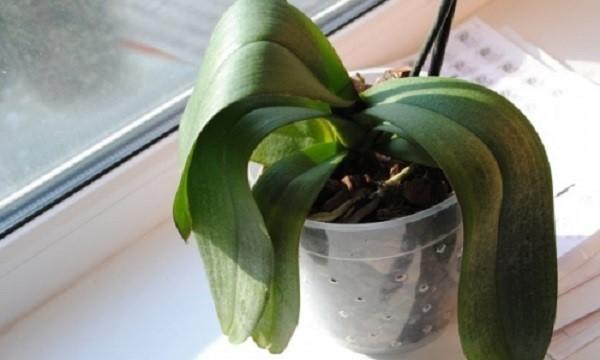Why orchid leaves lose their turgor and what needs to be done
 Orchid beauties require a little more attention than other flowers. This primarily concerns the creation of suitable growing conditions and providing them with proper care. If you do not follow the recommendations, plants can get sick and die, because they are very sensitive, especially with regard to watering.
Orchid beauties require a little more attention than other flowers. This primarily concerns the creation of suitable growing conditions and providing them with proper care. If you do not follow the recommendations, plants can get sick and die, because they are very sensitive, especially with regard to watering.
One of the most common problems encountered by Orchomaniacs is leaf wilting. Healthy orchid has a hard, resilient leaf plate of rich green color, filled with moisture. And if the leaves of the flower become lethargic and soft, like rags hanging down, then it is urgent to start resuscitating it.
Reasons for the loss of turgor by an orchid
In most cases, orchid leaves become soft and acquire a characteristic structure (covered with deep "wrinkles") as a result of moisture loss. But the cause of this problem can be various factors. If only one or a few of the lower leaves wither, but the rest have a good turgor, this is a completely natural process, thus, the orchid sheds old leaves.
In the case of wilting of all leaves, the cause of the loss of turgor can be:
- excessive drying of the soil (if watering is missed);
- decay of roots;
- excess fertilizer;
- too high a temperature;
- cramped pot.
With natural dying off, nothing needs to be done with the orchid, until the leaf completely dries up, it is still able to feed the plant. Over time, the leaf itself will turn yellow and dry, but then it can already be removed.
How to restore leaf turgor?
A drooping orchid, which for a long time remained without watering in dry bark, must be shed well and the air humidity must be increased. To do this, spray the leaves regularly.
If watering was carried out in a timely manner, the substrate did not dry out, but the leaves are still lethargic, which means that the orchid cannot deliver moisture to them due to the loss of roots. Decay of the root system, in turn, provokes abundant and frequent watering.
In this case, remove the plant from the pot, remove rotten soft roots and transplant into fresh substrate. If the root rotted only from the edge, but at the same time has a healthy beginning, only the damaged part should be cut off until healthy tissue appears at the cut site. It is not necessary to completely cut it off, because it is still capable of feeding the orchid.
Periodically, it is necessary to transplant the flower, since in a cramped pot the roots begin to crawl out and are no longer able to fully provide the plant with moisture.
We should also mention the role of the summer period in the development of orchids. The optimum temperature for flowers is 25 degrees Celsius. In the summer, it often exceeds the specified norms, especially if the pot is on a window near the glass, and as a result of overheating, the leaves wither. It is urgent to rearrange the orchid to a cooler place and spray.